Building healthier communities
January 24, 2012
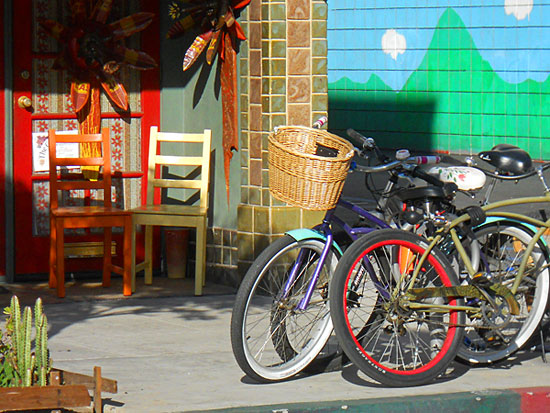
A new ordinance means bike parking must be a part of new developments in unincorporated L.A. County.
What does the width of your sidewalk have to do with the diameter of your waistline?
What do shade trees have to do with how active you are?
And what does bicycle parking have in common with farmers markets and community gardens?
They’re all elements in Los Angeles County’s new Healthy Design Ordinance, initially approved by the Board of Supervisors Tuesday, and now receiving finishing touches from county attorneys.
The ordinance, expected to become law in March, represents part of a new and increasingly important partnership between planners and public health officials trying to fight an epidemic of obesity, diabetes and other diseases by making it easier for people to adopt a more active lifestyle.
To the delight of bicycle advocates, the new ordinance would require for the first time that bike parking be included in new developments in unincorporated parts of Los Angeles County. (Similar provisions are included the county’s proposed Bicycle Master Plan, which is expected to come before the board in coming weeks.)
To foster more walkable communities, the Healthy Design Ordinance also would mandate 5-foot wide sidewalks instead of the current 4-foot standard. And, to make sure those wider sidewalks are inviting, it would require that shade trees be included in future development plans.
It also seeks to bring healthy vegetables and fruits to so-called food deserts by making it easier for farmers markets and community gardens to take root in residential and other areas without a lot of red tape. And written into the ordinance is a requirement that those markets accept CalFresh payments.
Dr. Jonathan E. Fielding, the county’s top public health official, said his department was happy to have invested part of a 2010 grant it received from the federal Centers for Disease Control and Prevention to help get the Healthy Design Ordinance off the ground.
It’s all part of a shift in tactics to move disease prevention out of the doctor’s office and into the streets.
“If we want to improve the health of Angelenos, we need to start by improving our physical environment and our social environment,” Fielding said.
Supervisors praised the work that has been done so far.
“This is a big idea. This is forward-looking. This is progressive policy-making,” said Supervisor Mark Ridley-Thomas.
Board of Supervisors Chairman Zev Yaroslavsky, who initially proposed the measure along with Supervisor Don Knabe, also saluted the efforts. But he said the new ordinance is just a first step toward designing a healthier county.
“Much more needs to be done to create livable neighborhoods that do not rely solely on automobile transportation,” Yaroslavsky said. “County planners and engineers, and private developers, will have to make a concerted effort to achieve neighborhoods where people feel comfortable walking, biking, and taking transit.”
In a motion adopted along with the board’s vote Tuesday in favor of approving the ordinance, Yaroslavsky directed county staff to take a closer look at “zoning and land use policies that encourage sprawling developments which force people to drive vast distances just to get to work, or buy a gallon of milk.”
At the same time, the motion recognized that there are no one-size-fits-all approaches, and that not all healthy design features will apply to every community.
A rethinking of what planning can mean to the health of communities and individuals is “actually pretty exciting,” said Susan Tae, a supervising regional planner who led the Healthy Design team for Regional Planning. “To create a more pleasant environment is to encourage a pedestrian to take a walking trip rather than jump in a car.”
(For a look at some of the guidelines the team came up with in developing the ordinance, click here. And a two-minute summary of the ordinance’s main points is here.)
Tae said other initiatives, such as the upcoming Bicycle Master Plan and a new specific plan to create a more walkable area around Gold Line stations on the 3rd Street Corridor inEast L.A., will help move the spirit of the new ordinance forward.
Designing for health, she said, requires thinking like a walker or cyclist and constantly asking: “How do we create things at more of a pedestrian scale?”
“If it’s not comfortable,” Tae said, “then it’s not going to be used.”
Posted 1/24/12
A Bowl full of summer superstars
January 24, 2012
Even by the standards of the star-studded Hollywood Bowl, this season’s lineup features an unusual concentration of needs-no-introduction talent.
From Liza Minnelli, Barry Manilow and Smokey Robinson to Yo-Yo Ma, Gustavo Dudamel, Itzhak Perlman and Plácido Domingo, the schedule unveiled Tuesday offers a rich blend of popular entertainment and artistic innovation.
Garrison Keillor, Juanes, Rubén Blades, Herbie Hancock, Norah Jones, Diana Krall, Anita Baker and Ben Harper will be among the featured performers. Also on tap: a fully staged production of The Producers, crowd-pleasing Grease and Sound of Music singalongs, and Pixar in Concert, blending film clips and musical scores from Toy Story and beyond.
Beethoven’s 9th Symphony, meanwhile, will be experienced in a new way—with video imagery celebrating Gustav Klimt’s Beethoven Frieze accompanying the Ode to Joy finale. (The performance is a Los Angeles Philharmonic-Getty Museum collaboration.)
Among the artists listed as making their Hollywood Bowl debut this season is this promising newcomer: Supervisor Zev Yaroslavsky, who will take the stage on Sept. 11 to narrate Copland’s A Lincoln Portrait. (He has previously narrated the work, but not at the Bowl.)
Subscription series tickets are on sale now. Single concert ticket sales start May 5. Check out the full lineup here.
Posted 1/24/12
Bike lessons from Long Beach
January 24, 2012

Supervisor Zev Yaroslavsky and a team, including county engineers, recently hopped on bikes and took a look at street strategies that could be applied across the county. On their cycling tour of Long Beach–which makes no secret of its aim of knocking Portland off its perch as America’s most bicycle-friendly city–they pedaled along innovative bike boulevards, green sharrows and a spectacular stretch of the Pacific. Their takeaway: where there’s a will, there’s a bikeway.
Posted 01/19/12
Embracing the dark side in rural L.A.
January 24, 2012
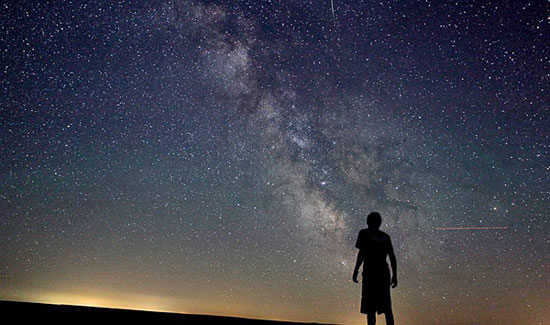
The county's new "dark skies" law may not lead to this kind of view, but it's certainly a step forward.
“Light blight.”
That’s Kim Lamorie’s term for the spectacle that occurs every time an urbanite moves to one of the rural communities near her Calabasas home. The sun sets, the black night settles over the Santa Monica Mountains, and before long, “their houses and yards are massively lit up like crazy,” says Lamorie, president of the Las Virgenes Homeowners Federation.
“It’s how you can tell when somebody’s new to the rural area.”
Eventually, she says, the newcomers come to realize that they don’t need all that security lighting and that bright lights confuse and even threaten the nocturnal animals that share their wilderness. But in the meantime, she says, all that fear of the dark can ruin one of the best aspects of mountain living:
“I can step outside my door at night,” she says, “and see the stars.”
On Tuesday, after more than a year of preparation, the Board of Supervisors restricted outdoor lights in rural Los Angeles County in an attempt to curb light pollution in such unincorporated areas as the Antelope and Santa Clarita valleys and the Santa Monica Mountains.
The new regulations create a Rural Outdoor Lighting District that encompasses those and other sparsely populated parts of the county and requires that lights on barns, corrals, ball fields and other such facilities be shielded so that they face downward, not outward and upward. It also requires outdoor lights, such as those on patios, be subdued enough so that they don’t “trespass” onto neighboring properties.
Although a handful of public safety facilities, such as those operated by the Sheriff and Probation departments, will be exempt from the restrictions, most rural landowners—including the county—must comply with the requirements. That mandate was stressed in a motion by Supervisors Zev Yaroslavsky and Michael D. Antonovich after the Department of Public Works issued rough, last-minute estimates indicating that the cost of replacing lights on the agency’s rural buildings would be so high that would be so high that they would have to dip into funds otherwise reserved for road projects.
“The Department of Public Works should find cost effective ways to comply with the ordinance like every other stakeholder, and they should do so out of their existing . . . budget,” Yaroslavsky and Antonovich said in their motion, calling the estimates “not credible.”
The new rules give county departments six months to report back on how they’ll comply. Homeowners will also get an initial grace period, after which enforcement will be based on complaints. For commercial and recreational facilities, such as ball fields and businesses, lights must be turned off either an hour after a game’s end, at the close of business or at 10 p.m., whichever is the latest.
Rural homeowners applauded the ordinance, championed by Antonovich and Yaroslavsky.
“Out here in the country, most people want to see the stars. And if your neighbor’s got tons of lights, and they don’t shut them off, it really does cause a problem,” said Wayne Argo, who lives in the Antelope Valley on three acres near the Angeles National Forestand who is director of the Association of Rural Town Councils.
“A couple of years ago, we had problems in Leona Valley with people using arena lights on their horse property and not turning them off at a reasonable time,” he said. “For the people in the area, it was like having a baseball field or a football field next door.”
As civilization has encroached on once-unspoiled horizons, city lights have eclipsed more and more of the night sky. Already, astronomers say, the Milky Way has become invisible in two-thirds of the country; after the 1994 Northridge earthquake, the Griffith Park Observatory reports, frightened Angelenos called when the power went out, wondering what the weird, silvery shimmer was in the night sky.
“Some thought it was the end of the world,” according to the observatory’s website. “It was, in fact, the stars.”
Some of the first calls for a curb on light pollution came from stargazers in Arizona. The city of Flagstaff passed one of the first anti-light pollution ordinances in 1958 to stop searchlights from impairing the work of astronomers at Lowell Observatory, where Pluto had been discovered. Then, in 1972, the city of Tucson began requiring city lights to be pointed downward to protect the Kitt Peak National Observatory.
By the mid-1980s, a state statute had been enacted in Arizona, and in 1988, astronomers in Tucsonfounded the International Dark-Sky Association (IDA) to advocate on the issue. The IDA now has 58 chapters in 16 countries, helping draft model light pollution ordinances for communities.
In California, the city of San Joseswitched to low-pressure sodium lights in the 1980s to protect the nearby Lick Observatory; San Diego used regulations to dim the skies for the Palomar and Mount Laguna observatories as well.
In recent years, however, the dark skies movement has moved beyond astronomy to touch on environmental, health and lifestyle questions. The loss of darkness has, for example, also affected the feeding, mating and migration habits of wildlife from bats to sea turtles. Meanwhile, medical researchers have uncovered links between the incidence of breast and prostate cancer and exposure to artificial light at night.
In 2002, the city of Calabasas, which abuts the unincorporated Santa Monica Mountains, passed its own local light pollution ordinance, largely to preserve the rural character and local ecology of the community. According to a recent issue of the Las Virgenes Homeowner’s Association newsletter, in the last four years, the city has fielded only about nine complaints of light trespass, all involving commercial night lighting.
Both Lamorie and Argo hope further public education also will be a big part of the county’s light enforcement. And for those who are still not convinced of the new law’s value, Argo has a suggestion.
“You wait ‘til a half-hour or so after sunset, then sit down in a lawn chair, and lay your head back, and look straight up,” Argo said. “You can see satellites. You can see all the constellations. On a clear night, you can almost reach up and touch the Milky Way.”
Posted 1/24/12
A public comment of my own
January 24, 2012
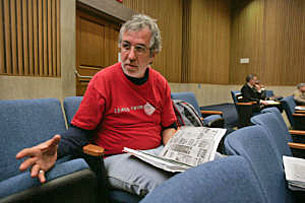
Gadfly Arnold Sachs says he likes to "annoy the board" by speaking on every agenda item. Photo/Daily News
For the past several weeks, a lot has been said and written about my proposal to modify the amount of time each member of the public is allotted for comment during our weekly Board of Supervisors meetings.
Unfortunately, much of that discussion has lacked balance, context and, at times, accuracy, thus serving mostly to misinform people about what I’d hoped to achieve upon becoming the board’s chairman in December. As a result, the prevailing narrative has become this: we on the Board of Supervisors believe that when it comes to our meetings, the public should be neither seen nor heard.
The most recent example of this was a lengthy story in Saturday’s Los Angeles Times. Appearing on the front page, it flatly and wrongly asserted that I think “members of the public talk too much” and mischaracterized fundamental elements of the proposal. Inexplicably, I was never asked for my comment, even though the piece was aimed squarely at me. Had I been asked to do so, readers would have come away with a fuller understanding of the issue.
The truth is I wish we had more public engagement. Our huge hearing room is often empty, despite the breadth and enormity of matters the board confronts every week. In this regard, we are not alone. Visit City Hall and you’ll find much the same. Recent coverage would have you believe that we want to yank the microphone on a public that’s clamoring to be heard. This is not the case.
Most weeks, the same tiny cadre of individuals speak on a multitude of agenda items—sometimes dozens of them in a single meeting. Under the current practice, they’re allowed to talk for two minutes on each item and then can speak for an additional three minutes at the end of the meeting on non-agenda matters. One of these so-called gadflies admitted to a Daily News reporter recently that he had signed up to talk on every agenda item simply to “annoy the board.”
Of course, this is his right—as it is the right of another of our regular speakers to participate in this weekly spectacle by repeatedly delivering the same racially-tinged diatribe against undocumented immigrants and reciting the names and addresses of those she alleges, without evidence, of being “gangbangers.”
But under California’s Ralph M. Brown Act, it’s also the right of government bodies to impose reasonable limits on public comment as a way to ensure a healthy balance among all stakeholders in the meeting process. All our local legislative bodies have rules to this effect, including the Los Angeles City Council. In this spirit, and at the suggestion of our County Counsel, I proposed that our rules be modified to give speakers a three-minute block to discuss their agenda items—rather than two minutes for each one—and two minutes at the end of the meeting for general comment.
While this might be a tight squeeze for the small number of gadflies bent on testifying about virtually every matter before us each week, we considered it a fair policy for the vast majority of people who, in good faith, take time out of their days to travel downtown and speak on the one or two issues that directly affect their lives.
Now, we’ve put the proposed changes on hold so that our county attorneys have time to correct misperceptions and explain the board’s motivation to concerned stakeholders as we move forward.
For those of you who’ve followed my time in public life, you know that I’ve been a consistently strong advocate of government transparency—a record that includes, among other things, my successful push to make board meetings available to a wider audience by having them webcast, televised and posted online with transcripts. As some of you may also remember, I authored Los Angeles’ first freedom of information act while serving on the City Council.
So I encourage you to join me at a Tuesday Board of Supervisors meeting and see for yourself what all the controversy is about. You be the judge. Take it from me, you can’t trust everything you read.
Posted 1/24/12
Calling all e-waste in Woodland Hills
January 19, 2012
Got an old computer, printer, cell phone or TV to unload? Recycle it on Saturday, January 21, at Serrania Avenue School in Woodland Hills from 9 a.m. to 4 p.m.
The event, sponsored by Friends of Serrania, is free and will accept all kinds of discarded electronics equipment. Proceeds from the recycled items will help fund student programs at the school.
The school is located at 5014 Serrania Avenue in Woodland Hills. For more information, click here.
Posted 1/19/12
Bike lessons from Long Beach
January 19, 2012

Over the past five years, Long Beach has been accelerating its bicycle amenities in innovative ways.
With the county’s first bicycle master plan in decades heading into the homestretch, Supervisor Zev Yaroslavsky and a team including engineers and members of the Los Angeles County Bicycle Coalition recently hopped on bikes and took a look at what the future might hold.
On their cycling tour of Long Beach—which makes no secret of its aim of knocking Portland off its perch as America’s most bicycle-friendly city—they pedaled along innovative bike boulevards, green sharrows and a spectacular stretch of the Pacific.
Their takeaway: where there’s a will, there’s a bikeway. Ride along for a first-hand view.
Posted 1/19/12
The long and short of surfboards
January 19, 2012
When surfing got big in the 1960s, the boards got small. Maneuverable “shortboards” revolutionized surfing, allowing surfers to move freely in waves and test out new moves. The California Heritage Museum explores shortboard-making in Surfboard Revolution: Surf Design 1967-1984.
The exhibit features 70 antique boards from such surf icons as Tom Blake, George Greenough and Miki Dora. As shortboards evolved, the different styles created were given names like “Pintails,” “Guns” and “Wingers.” A 1980s-style shaping room has been set up for the exhibit, and shapers like Bob Hurley and Nathan Pratt will occasionally stop in to work on new boards. Surfing photos and magazine covers from the period round out the display.
The California Heritage Museum is located in the historic landmark Roy Jones House at 2612 Main Street in Santa Monica. Hours are 11 a.m. to 4 p.m., Wednesday through Sunday. General admission is $8, $5 for students and seniors, and free for kids under 12.
Posted 1/19/12
Affordable housing still matters
January 18, 2012
Redevelopment agencies may have begun with noble ideals. But all too often in recent years they have devolved into slush funds for insiders—not to mention a bureaucratic means of denying our schools, social service agencies and fire departments the resources they needed to make California a better place to live and work. Auditors throughout the state are now starting to open the books of these agencies. And I believe the public will be shocked by what they find—including huge sums wasted on frivolous projects or left to idle in agencies’ coffers while vital community needs were ignored.
So I applaud the California Supreme Court’s recent decision to uphold state legislation that puts redevelopment agencies out of business starting February 1.
But that doesn’t mean we can afford to ignore the funding stream that some of these redevelopment agencies—notwithstanding their glaring flaws—provided for desperately-needed low- and moderate-income housing, along with some other legitimate local development purposes.
So this week, we took the first steps toward making sure our current affordable housing programs transition smoothly to new management as our redevelopment agency dissolves, and receive the strong and appropriate levels of oversight mandated by the new state law. (Here is the motion I co-sponsored with Supervisor Mark Ridley-Thomas.) We also directed county staff to begin working on a new framework for how we will fund and manage affordable housing programs going forward. (My motion is here.)
There’s not a moment to waste.
At a time when federal housing resources are being slashed by nearly 50% each year, Los Angeles County must take the lead in quickly identifying ways to continue providing the means to build affordable housing for the most vulnerable among us.
Over the past few years, the need for such housing has skyrocketed as the resources have shrunk exponentially. A recent survey found there were nearly 200,000 people on the waiting list for Section 8 housing in Los Angeles County—and that the waiting period is now 10 years. It’s even worse in some cities within the county, including one, in our own 3rd District, where the wait is an astronomical 399 years.
As Los Angeles County and other jurisdictions up and down the state adjust to the complexities of life after redevelopment agencies, we must not lose sight of all the human need behind those terrible statistics.
And we can’t let California’s decision to dismantle these agencies deter us from our responsibility to help people get access to housing they can afford.
Posted 1/18/12








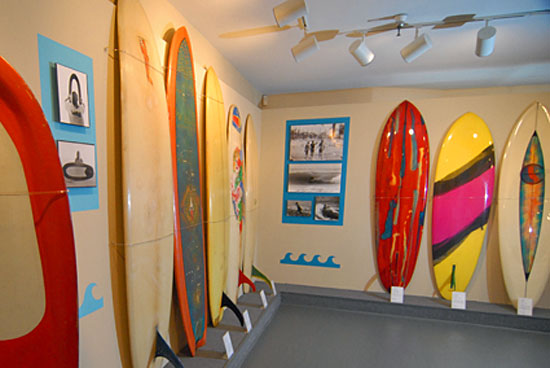
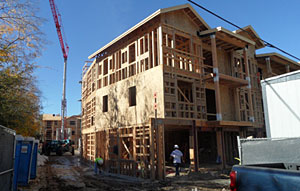





 Check for the latest closure information
Check for the latest closure information








